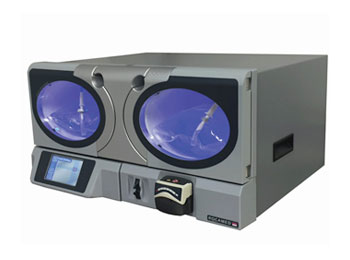Product Line Includes Double Chamber Pump System and Ten Types of Tubing for Consistent Pressurized Pump Capabilities, User-Friendly Heating and Adjustable Suction for All Endo-Urology Needs

Olympus is now the exclusive distributor of the RocaFlow Pump and Tubing Sets, which feature a double chamber pump system and 10 types of tubing for consistent pressurized pump capabilities, user-friendly heating and adjustable suction for all endo-urology needs.
CENTER VALLEY, Pa., (November 12, 2019) – Olympus, a global technology leader in designing and delivering innovative solutions for medical and urology procedures, among other core businesses, announced today its exclusive U.S. distribution agreement with Rocamed, an innovator of quality medical products, based in Monaco and a leader in European markets. Olympus will distribute the RocaFlow Double Chamber Pump System and Tubing Sets for use in urology procedures including ureteroscopy for kidney stones and trans-urethral resection of the prostate (TURP). The product line includes a double chamber pump system for the consistent pressure necessary for procedural control and 10 different types of tubing sets. The RocaFlow system is the only offering of its kind to combine three capabilities of suction, heating and pressurization.
For endo-urology, optimal visualization is obtained through irrigation, flowing saline or sterile water through the scope to create a working space within the prostatic region or kidney and to clear this region of debris from stone fragments, tissue or blood. Pump and suction technology are required for irrigation. Irrigation-induced intrarenal pressure is of concern when using high pressure irrigation, as it may increase the risk of systemic inflammatory response syndrome (SIRS) due to increased pyelovenous and pyelolymphatic absorption, which can be linked to infection.i,ii,iii The RocaFlow pump system is designed to address physician concerns related to possible over-pressurizing, by offering a steady pressure application even at a very low pressure reading, versus the standard peristaltic pumping technology. The RocaFlow pump system also offers heating of operative fluid (saline, sterile water), a suction system for outflow and a pressurized system. The pump system can be connected to either the pressurized air port on the wall in the facility, or to a pressurized medical air canister.
Benefits of the RocaFlow Double Chamber Pump System include:
- Visualization – Operative fluid flow, made possible through suction and pumping, allows irrigation to clear visual and physical obstructions to the procedure.
- Controlled Temperature of Saline – Allows physicians full control of heat as desired for potential reduction in risk of hypothermia.
- Greater Procedural Control – Non-peristaltic pumping provides steady application of pressure, for more control versus standard pulsating peristaltic pumping technology, for example enabling the surgeon to approach the kidney stones without the risk of ''flushage'' or pushing the stone back into the kidney. Consistency is possible even with low pressure (40cm), which helps address physician concerns related to possible over-pressurizing of the kidney while also providing time-savings because staff is not required to stop irrigation to make pressure adjustments.
- Ease of Use and Small Footprint – Instead of hanging a gravity bag for fluid during the procedure, the nurse and staff will simply put the bags of fluid inside the pump chambers and set the pressure setting per physician instructions.
- Adjustability – Tubing comes specialized for TURP and Stone procedures, as well as for specified functions including irrigation, pumping and post-op. Additionally, options include the Gravity tube set which allows physicians to simply hang a bag while increasing flow with the Traxer hand pump.
“The combination of pressure, heating and suction in one fluid management system is impactful to me and the staff of our busy urology practice,” said Dr. Jorge Gutierrez- Aceves, Professor of Urology at Wake Forest Medical Center. “The ability to approximate the fluid pressure in the renal pelvis is a valuable sepsis prevention tool. Our anesthesia team appreciates the heating capability because it counterbalances a drop in body temperature during the procedure. And the steady flow of fluid helps optimize my endoscopic view, especially during laser lithotripsy with stone debris.”
“We are excited about the additional breadth this distribution agreement gives our urology group, as well as the customers and patients who depend on our offerings,” said Randy Clark, President, Medical Systems Group, Olympus America Inc. “All of the benefits of these products are strategically aligned with our overall goal of bringing to market minimally invasive innovations – all toward better outcomes, reduced costs and improved patient satisfaction.”
Those interested in the RocaMed pump and tubing sets should contact local Olympus Sales Representatives for more information.
# # #
About Olympus Medical Systems Group
Olympus is a global technology leader, crafting innovative optical and digital solutions in medical technologies; life sciences; industrial solutions; and cameras and audio products. Throughout our 100-year history, Olympus has focused on being true to society and making people’s lives healthier, safer and more fulfilling.
Our Medical Business works with health care professionals to combine our innovative capabilities in medical technology, therapeutic intervention, and precision manufacturing with their skills to deliver diagnostic, therapeutic and minimally invasive procedures to improve clinical outcomes, reduce overall costs and enhance quality of life for patients. For more information, visit medical.olympusamerica.com.
i Fan, Song et al. Risk factors of infectious complications following flexible ureteroscope with a holmium laser: a retrospective study. International journal of clinical and experimental medicine vol. 8,7 11252-9. 15 Jul. 2015
ii Stenberg A, Bohman SO, Morsing P et al. Back-leak of pelvic urine to the bloodstream. Acta Physiol Scand 134:223–234. 1988.
iii Silvia Proietti, MD, FEBU,1,2 Laurian Dragos, MD,2,3 Bhaskar Somani, MD, MRCS, FEBU, FRCS,4 (2017) In Vitro Comparison of Maximum Pressure Developed by Irrigation Systems in a Kidney Model. J of Endourology, Volume 31, Number 5, May 2017.

